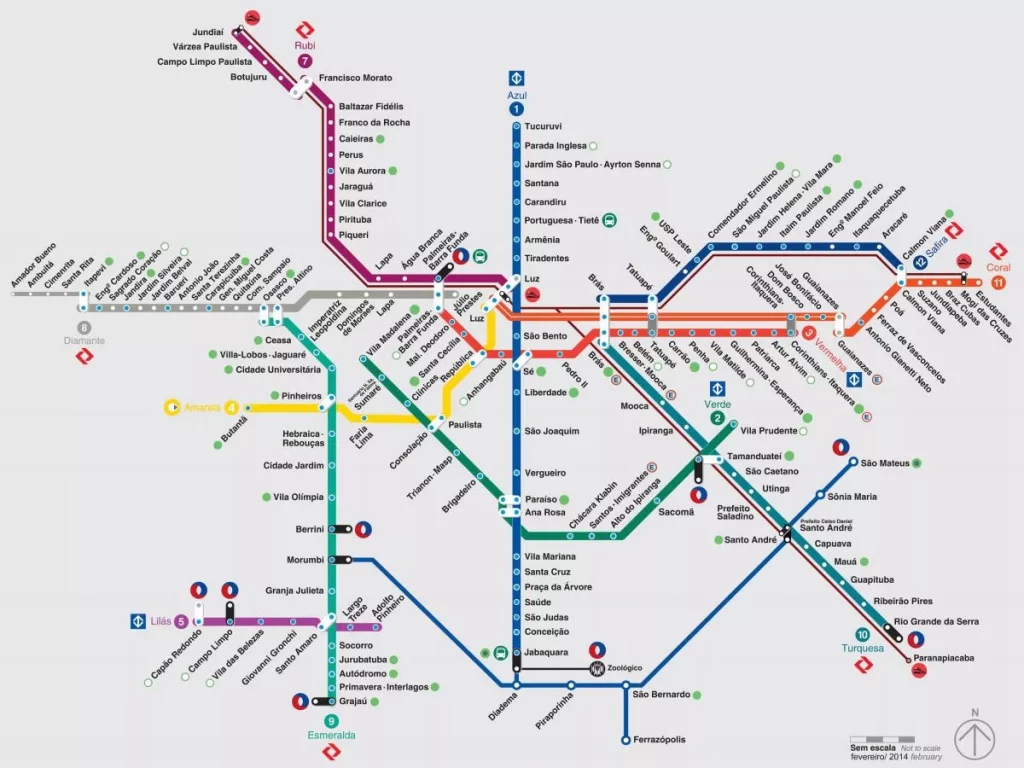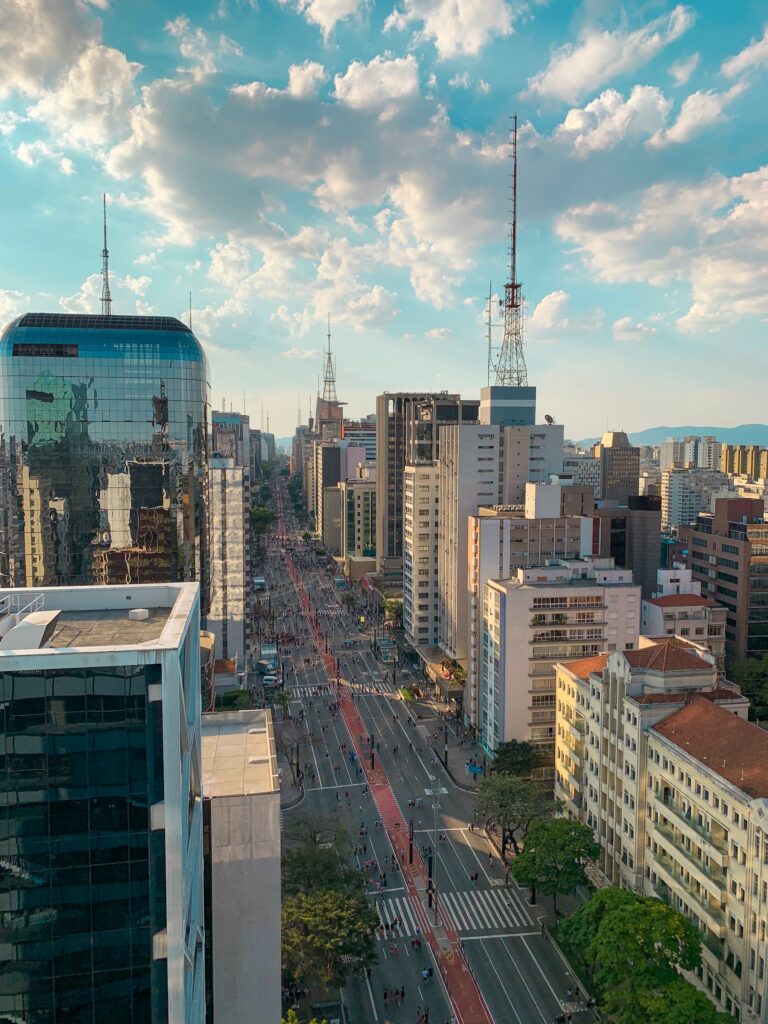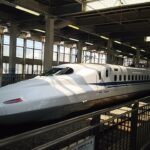The city of Sao Paulo is a bustling metropolis that has an excellently established network of public transportation. In addition to buses, metro trains, and suburban trains, the city of Sao Paulo also has a system of cable cars that are part of its public transportation network. The public transportation network is not only economical and user-friendly, but also quite effective at facilitating travel throughout the city. The subway system in Sao Paulo is one of the busiest in the world, making it an excellent option for getting about the city. Buses are another common kind of public transportation, and for good reason; not only are they dependable but they are also reasonably priced. In addition, the city has just recently introduced a bike-sharing program, which enables residents and visitors to rent bicycles from a variety of stations located all over the city.
Metro system in Sao Paulo – Basic information
One of the most crowded subway systems in the world may be found in Sao Paulo, Brazil. There are six separate lines and more than 100 kilometers of track in all. The Companhia do Metropolitano de Sao Paulo (CMSP) is the organization in charge of running it, and it provides service to the city of Sao Paulo as well as parts of its suburbs. People in Sao Paulo have access to a method of transportation that is dependable and time-saving thanks to the metro system, which is an essential component of the city’s public transportation network. In addition to this, it is relatively inexpensive, with individual tickets costing only a few dollars each. More than one thousand trains run throughout the day on the metro system, which is operational from four in the morning until twelve in the night. Because it is so well-kept and secure, it is an excellent choice for tourists as well as residents of the area.
The most important lines of the Sao Paulo subway system
Line 1 – Blue (Linha 1 – Azul)
One of the six lines that comprise the Sao Paulo Metro, as well as one of the thirteen lines that comprise the Metropolitan Rail Transportation Network. It was the first line constructed for the Sao Paulo Metro and the first line constructed anywhere in Brazil for a metro system. It provides a connection between the Tucuruvi and Jabaquara stations.
Line 2 – Green (Linha 2 – Verde)
Currently, service is provided between Vila Madalena and Vila Prudente stations. Because it passes through a significant portion of the Avenida Paulista, one of the most important financial centers in Sao Paulo, the line is also known as the Paulista Line and was formerly known by that name. This line connects both the West and the South-East regions.
Line 3 – Red (Linha 3 – Vermelha)
It connects the neighborhoods of Palmeiras-Barra Funda and Corinthians-Itaquera. Historically, this was known as the East-West Line. Number 3 is the busiest line in the system.
Line 4 – Red (Linha 4 – Amarela)
Formerly known as the Southeast-Southwest Line, the line stretches from Vila Sônia to Luz. It is 12.8 kilometers long, has 11 stations, and carries approximately 800,000 passengers daily. It is the first metro line in the region to feature autonomous trains and platform screen doors at every station. This makes it one of Latin America’s most sophisticated subway lines. After completion, the 12.8-kilometer-long segment of Line 4 – Yellow will connect the stations of Vila Sônia and Luz.
Line 5 – Lilac (Linha 5 – Lilás)
2002 marked the completion of the section of the railway that runs between Largo Treze and Capo Redondo. It was envisioned at the time as a railway line operated by the CPTM and designated as Line G. The undertaking was relocated to the Sao Paulo Metro and subsequently renamed Line 5 – Lilac.
Line 15 – Silver (Linha 15 – Prata)
The Bombardier Innovia Monorail 300 is the first monorail system of its kind in South America and the world. Both of these distinctions were simultaneously accomplished. When completed, it will be the monorail system in the Americas with the maximum capacity and the largest scale, and the second largest in the world after the Chongqing Monorail. This line provides a free connection to Line 2-Green at the Vila Prudente station, and it will eventually provide a connection to CPTM Line 10-Turquoise at the Ipiranga station. The current length of the line between Vila Prudente and So Mateus is 11.6 kilometers, and it comprises 10 stations.
Map of Sao Paulo Metro 2023 – Free Download in PDF

Click on the image and download the map of Sao Paulo´s underground system for 2023
The PDF version of the map of the Sao Paulo Metro 2023 is available for free download. It is an indispensable tool for anyone who wishes to navigate the extensive public transit infrastructure that the city possesses. This map provides a comprehensive summary of the whole metro system, including all of the lines, stations, and connecting points. It is located here for your convenience. In addition to that, it provides useful information such as the price of tickets and the frequency of trains. With this map in your possession, it will be much simpler for you to plan your vacation and navigate the area in a rapid and effective manner.
Public transport tickets in Sao Paulo – Best types for travelers & actual prices
Buses are Sao Paulo’s most widespread mode of public transit and also its most cost-effective option. The price of a ticket for a single ride is R$3.75; however, if you plan to take numerous rides, you can purchase a 10-riding ticket for R$26.30 if you want to save money. This ticket is valid for travel on all buses and subway lines in the system.
The metro is the best option to use if you want to travel further than the bus will take you. A single ride on the metro will cost you R$3.80 for a ticket. On the other hand, if you plan on taking more than one journey, you can save money by purchasing a ticket that is good for 10 rides and costs R$25.50. This ticket is good for travel on any of the metro lines.
The railway is considered to be the most effective method of public transit in Sao Paulo. Although it is the one that will get you across the city the quickest, it will also cost you the most money. A ticket for a single ride costs R$4,90, but if you plan on taking numerous rides, you may save money by purchasing a ticket good for 10 rides for R$37.50. This ticket is valid on all train lines and can be used whenever you like.
The ideal choice for people who are going to be in Sao Paulo for a few days is to buy a tourist permit good for three consecutive days. This pass costs R$51 and entitles you to unlimited journeys on all bus, metro, and train lines for the duration of its validity period.
Getting to Sao Paulo is simple and uncomplicated regardless of which mode of transportation you select. You are certain to find a ticket option that meets your needs among all of these available alternatives. The three-day tourist permit is the most beneficial purchase for travelers who will be in town for three full days.
Summary of fares for public transport in Sao Paulo
- A one-way ticket for a bus cost R$3.75 and a 10-ride ticket costs R$26.30.
- Tickets for a single journey on the metro cost R$3.80 and a 10-ride card for R$25.50.
- Tickets for a single train journey cost R$4.90, and a 10-ride pass can be purchased for R$37.50.
Timetables & Schedules of the Sao Paulo Metro system
Every day of the week, from 4:30 am to midnight, the Sao Paulo Metro system is open for business. During peak hours, trains depart every 3-7 minutes, but during off-peak hours, they depart every 10-15 minutes. The last train of the night departs the station at 11:30 o’clock, with the exception of Friday and Saturday nights when the trains remain in service until 1 am. In addition, passengers have the option to take advantage of the Nocturno service, which is offered on Friday and Saturday evenings and runs from midnight until 4:30 am.
What Are Other Options For Public Transportation In Sao Paulo?
Sao Paulo, the largest city in Brazil, is a sprawling metropolis with a diverse array of available modes of public transit. There are a variety of options available besides taking the subway for people who would prefer not to use it to go around the city. There is a mode of public transit that caters to the needs of each individual traveler, be it buses, trams, or even bicycles.
In Sao Paulo, one of the modes of transportation that sees the greatest action is the bus. The city is served by an extensive bus network that links together all of the most important communities. People who are looking for a dependable method of transportation may want to consider taking the bus because it is not only reasonably priced but also quite clean and pleasant.
In Sao Paulo, the use of trams is a popular and distinctive kind of public transit. A large number of the neighborhoods in the central business district are served by the city’s vast tram network. The trams, which are frequently populated by both inhabitants and tourists, provide a wonderful opportunity to gain a better understanding of the city’s history and culture.
Those looking for alternative modes of transportation in Sao Paulo also have the option of riding bicycles around the city. Because the city is equipped with a vast network of bike lanes and bike rental stations, getting around on two wheels is both possible and convenient. Cycling around the city is not only a fantastic way to get some exercise but also to see more of it.
How To Get From São Paulo/Guarulhos International Airport (gru) To The City Center With Public Transport?
The first thing you need to do is make your way to the Tiete Bus Terminal. From the Sao Paulo/Guarulhos International Airport, long-distance buses often depart from this primary terminal. From the airport, you have the option of taking either a cab or a shuttle bus to travel to your destination. Taxis are the choice that is the quickest and most handy, but they can also be quite pricey. Although they take significantly longer, shuttle buses are a far more cost-effective option.
When you get to the Tiete Bus Terminal, you will need to buy a ticket for the bus that will transport you to the central business district of the city. The Airport-Congonhas Express is the fastest and most convenient way to go into the heart of the city; it departs the airport every 15 minutes and takes roughly 40 minutes to reach its destination. The buses come complete with amenities such as air conditioning, toilets, and comfy seating options.
You will need to make a transfer to the metro system after you have reached the central business district of the city. The Metro Line 1 (Blue) is the line that you should use if you want to get to your destination as quickly as possible. This line connects the central business district of the city with the northern and southern reaches of the city. The Metropolitan Area Transit Authority (Metro) provides a quick, easy, and affordable way to travel throughout the city.
The entire trip from the Sao Paulo/Guarulhos International Airport to the city center can take up to an hour and a half, depending on the amount of time spent waiting at the Tietê Bus Terminal as well as the amount of traffic along the route. On the other hand, if you do your research ahead of time and have some patience, taking public transit can be an easy way to go from the airport to the heart of the city.
What kind of sightseeing do you have to see if you visit Sao Paulo for the first time?
The most populous city in Brazil, Sao Paulo, is a bustling, multicultural metropolis that is brimming with fantastic sights and activities to take part in. The city of Sao Paulo is home to a wide variety of attractions, ranging from renowned museums to historic landmarks. The following is a list of the most popular tourist destinations in Sao Paulo.
Ibirapuera Park is often ranked as one of the top tourist destinations in all of Sao Paulo. This stunning urban park can be found right in the middle of the action and provides a wide variety of fun things to do for its visitors. Visitors have the option of going on a boat ride on the lake, taking a leisurely stroll in the park, or exploring the different art galleries and museums that are located there.
Everyone who has even a passing interest in art should make the effort to visit the Sao Paulo Museum of Art. The museum is home to a significant collection of paintings, sculptures, photos, and other types of works of art created by well-known artists from Brazil as well as from other parts of the world. Additionally, guests have the opportunity to investigate the museum’s permanent displays, which center on the history and culture of Brazil.
Another one of the city’s attractions that draws a lot of visitors is the Cathedral of Sao Paulo. This magnificent cathedral in the Gothic style was constructed in the latter part of the 19th century, and it is notable for its enormous stained-glass window, complex stone carvings, and large organ. The structure also operates as a cultural center, and it plays host to a variety of events and concerts.
Another one of the city’s fantastic points of interest is the Sao Paulo Zoo. The expansive zoo in question is home to a wide range of creatures, some of which include tigers, elephants, monkeys, and others. In addition, guests get the opportunity to tour the aviary, reptile house, and aquarium. In addition, throughout the year, the zoo provides a variety of educational activities in addition to special events.
One of the most well-known thoroughfares in all of Sao Paulo is the Paulista Avenue. This broad boulevard is bordered on either side by attractive trees or buildings of two stories. Visitors have the option of perusing the many restaurants and shops, or they can simply take a leisurely stroll and take in the sights.
Sao Paulo is a contemporary and bustling metropolis that is teeming with exciting places of interest to visit. This city has something to offer everyone, from thriving parks to renowned museums, and all in between. Therefore, you shouldn’t miss out on seeing some of the best sights that Sao Paulo has to offer.
Summary of our tour guide for Sao Paulo
Sao Paulo is not only the most populous city in Brazil but also one of the most populous cities on the entire planet. It is a major economic, cultural, and entertainment hub for the surrounding metropolitan area. The city is well-known for its exciting nightlife on its streets, its multifaceted culture, and its superior network of public transit. Residents have convenient access to all areas of the city because of the city’s extensive network of public transit, which includes buses, metro, and ferries. In addition, the city is equipped with a multitude of bicycle lanes and pedestrian pathways, making it simple to navigate without the use of a motor vehicle. The city of Sao Paulo is one that should be explored to the fullest because it has something for everyone.
Top 5 FAQs and answers about Sao Paulo public transport?
Which method of payment for Sao Paulo’s public transportation is the most convenient?
- The electronic card known as the Bilhete nico is the simplest and most convenient way to pay for Sao Paulo’s public transportation system. This card may be purchased at any metro or bus station, and it can be loaded with credits that can be used for any and all forms of public transportation. Additionally, the card can be redeemed for savings on specific routes as well as for exclusive promotions.
With what degree of dependability does the Sao Paulo public transport system operate?
- The public transportation system in Sao Paulo is, on the whole, very dependable. The metro and light rail lines, in addition to the buses, are typically on time for their departures and arrivals. However, there is a possibility of being late due to heavy traffic, road construction, or other unanticipated circumstances.
Do you feel safe using the public transportation in Sao Paulo?
- The public transportation system in Sao Paulo is, on the whole, a safe option. At the majority of the stops as well as on some of the buses, there are security guards and cameras installed to keep an eye on the activity. When traveling, it is essential to remain aware of your surroundings at all times and to adopt appropriate safety measures.
What time does the Sao Paulo public transportation system open and close each day?
- On weekdays, the metro and light rail lines are operational from 5 am to midnight, and on weekends, the hours are extended to 6 am to midnight. On weekdays, bus service begins at 5 am and continues until 8 pm; on weekends, it begins at 9 am and continues until 8 night.
Does the public transportation system in Sao Paulo offer any kind of discounts or deals of any kind?
- Yes, riders of the public transportation system in Sao Paulo can take advantage of a variety of different discounts. Student discounts, elder discounts, and discounts for those with impairments are all included here. There are also one-time deals and discounts available from time to time, so it is in your best interest to keep an eye out for these.







